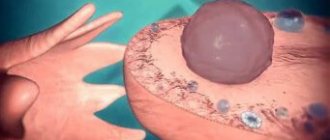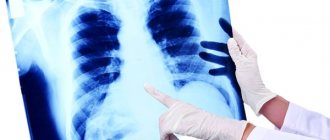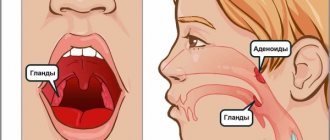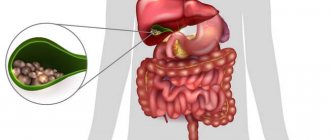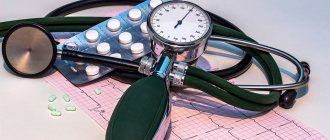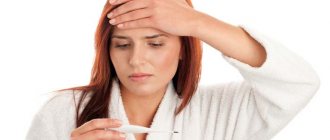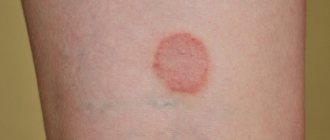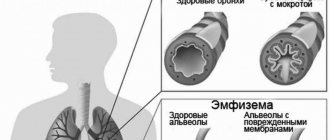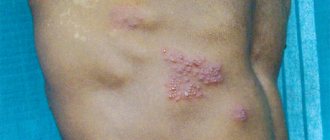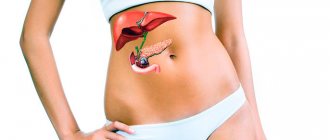Cholecystitis or inflammation of the gallbladder is a pathology that occurs against the background of prolonged stagnation of bile or due to the presence of other concomitant diseases of the hepatobiliary system. The disease is most often found in adults aged 40 to 60 years. Cholecystitis can occur in pregnant women. You should know what symptoms accompany the pathology and how to deal with it.
What types of gallbladder diseases exist?
IMPORTANT: Bile is a liquid that is produced by liver cells. An important function of bile is to remove toxic substances and metabolic products from the body. is necessary for the absorption of fat-soluble vitamins A , D , E , K.
Gallbladder diseases can greatly affect the body's digestive process. And that means throughout his work as a whole. Today, such problems in the work of this organ are known as: • Gallstone disease ; • Biliary dyskinesia ; • Chronic and acute cholecystitis ; • Tumors of the gallbladder and its ducts .
Gallstone disease is, as the name implies, the appearance of stones in the gall bladder. They consist of salts, cholesterol and other substances. The appearance of such stones is associated with increased cholesterol levels in the body against the background of decreased production of phospholipids and bile acids. This disease is often hereditary. It may also be associated with diabetes and obesity.
Biliary dyskinesia is a disorder associated with the motor function of the biliary tract. The result of this disease can be stagnation of bile or, on the contrary, its excessively intense secretion. Biliary dyskinesia can occur due to stress and excessive stress on the body.
Chronic cholecystitis is inflammation of the gallbladder that occurs due to various infections. The causative agents of such infections can be various bacteria and microbes. Cholecystitis requires immediate treatment.
Tumors in the gallbladder can be benign (polyps) or malignant. To prevent problems in the gallbladder area, people prone to such manifestations need to regularly undergo ultrasound examinations of this organ.
Bile ducts
The most important common bile duct is formed as a result of the fusion of the cystic (departs from the neck of the bladder) and hepatic ducts. In turn, the common bile duct consists of 4 sections:
- Retroduodenal - located behind the upper horizontal region of the duodenum (duodenum);
- Supraduodenal - localized above the duodenum;
- Intramural - in the wall of the vertical part of the duodenum;
- Retropancreatic - posterior to the head of the pancreas.
The mechanism of bile excretion is as follows:
- Bubble contraction;
- Opening of the bladder valve;
- Opening of the sphincter of Oddi;
- Influx of bile into the duodenum.
Symptoms of the disease
Each of the above gallbladder diseases has its own symptoms.
If they are detected, it is necessary to urgently be examined by specialists. Any deviations in the formation and excretion of bile can lead to harmful consequences. Symptoms of cholelithiasis are: • acute pain that occurs in the right hypochondrium; • nausea; • vomit; • elevated temperature.
IMPORTANT: It is necessary to remove stones from the gallbladder only when they interfere with the normal functioning of the organ. If this does not happen, then you can live to old age with gallstones.
Symptoms dyskinesia are: • acute pain that occurs in the right hypochondrium; • strong heartbeat; • sweating; • headache; • nervousness; • bitterness in the mouth; • disruption of the menstrual cycle in women; • biliary colic.
To effectively treat this disease, the doctor must find the causes that provoked it. Since one of the causes of this gallbladder disease is stress, psychotherapeutic help is necessary for its treatment.
Symptoms of chronic cholecystitis are: • pain in the right hypochondrium; • vomit; • skin itching; • increased body temperature; • flatulence; • psycho-emotional disorders; • pain in the heart area.
IMPORTANT: Treatment of chronic cholecystitis is a complex of measures consisting of diet, antibacterial therapy, choleretic and antispasmodic drugs and physiotherapy.
When tumors form in the described area, patients may experience pain, nausea, increased organ size, increased body temperature, itchy skin, black stools and sudden weight loss. Oncological diseases of the gallbladder are treated with surgery and chemotherapy.
Diagnostic measures
If symptoms of gallbladder disease appear, you should consult a doctor. The specialist will prescribe the necessary laboratory and instrumental tests and determine treatment tactics.
To identify gastrointestinal diseases, instrumental and laboratory studies are carried out
Using a blood test (general and biochemical) you can identify an inflammatory lesion or a disorder in the functionality of the gallbladder. The disease can be indicated by an increase in the concentration of leukocytes, a change in ESR (erythrocyte sedimentation rate), and an increase in the amount of bilirubin.
During duodenal intubation, the patient is inserted into the duodenum. This is necessary to collect bile and examine it. Using this diagnostic method, you can determine the composition of bile and the presence of white blood cells (leukocytes) in the mucus. These indicators indicate inflammation. In addition, it is strongly recommended to carry out bacterial culture of liver secretions to identify the causative agent of the infectious disease.
Using ultrasound, congenital anomalies (for example, a bend of the gallbladder) and neoplasms are detected. Precise equipment will show the thickness of the organ, its diameter, location, etc. Sometimes the gallbladder is not visible on the image, then there is a suspicion of a disabled gallbladder.
A biopsy (sampling of tissue cells) can detect gallbladder cancer.
If pain occurs on the right side under the ribs, an x-ray using a contrast agent is often prescribed. Using the study, the dimensions of the organ are assessed and deformation is identified. X-ray examinations are prescribed if a disconnected gallbladder is suspected.
Using computed tomography and magnetic resonance imaging of the abdominal organs, the size and location of the organ, various tumors, stones (even small ones), and polyps are revealed. These diagnostic methods are used for stagnation of liver secretions in the gallbladder.
What foods are prohibited for gallbladder diseases?
If you have gallbladder diseases, you must exclude from your diet: • Fatty (rich) broths; • Fried foods and fatty foods; • Spicy seasonings; • Smoked products; • Alcohol (even beer); • Baked goods and various confectionery products.
You also need to minimize in your diet such foods as: onions, garlic, radishes, horseradish and other vegetables and fruits that contain substances that irritate the gastric mucosa. Ice cream and many chilled drinks also have a negative effect on the gallbladder.
IMPORTANT: If you have the above problems, first of all you need to exclude from your diet foods that contain large amounts of cholesterol, as well as foods rich in animal fats. Such fats in the body need to be replenished with foods containing Omega3 and Omega6 acids.
Drug therapy
The following groups of drugs are classically prescribed:
- cholagogues,
- ursodeoxycholic acid,
- antispasmodics,
- antibiotic spectrum drugs,
- analgesics,
- anti-inflammatory drugs.
Contraction of the organ can be calmed with a sedative.
To dissolve stones, medications are used: henafalk, henahol, henadol, henasan. The tablets must be taken strictly according to your doctor's prescription.
What foods are allowed for gallbladder disease?
For problems with the gallbladder, the following foods and dishes are recommended: • Vegetable soups; • Boiled lean meat; • Fresh and baked vegetables and fruits; • Dairy products; • Buckwheat and oatmeal; • Grain bread; • Olive oil.
IMPORTANT: To cleanse the liver and gallbladder, you need to consume more foods that contain fiber. Particularly useful in this regard are water-soluble dietary fibers – pectin. It is with their help that toxins, cholesterol and other harmful substances are removed from the body. Pectin is found in large quantities in plums, figs, peaches, apples, bananas and beans.
Prevention and therapeutic diet
An excellent preventive measure is moderate physical activity - walking, morning exercises, cycling, swimming.
Pain in the right hypochondrium can be prevented by food, medications or herbs with a choleretic function - corn leaves, birch leaves, agrimony.
To reduce the risk of pathology, dietary ration No. 5 is prescribed. This diet is based on the most optimal composition of nutrients.
Avoiding stressful situations, maintaining a healthy lifestyle, maintaining a healthy diet and getting rid of bad habits will help prevent the risk.
Medicines for gallbladder disease
IMPORTANT: It is necessary to select drugs for the treatment of diseases of this organ with the help of a gastroenterologist.
For complex treatment of the gallbladder, drugs based on ursodeoxycholic acid ( Ursosan , Choludexan , Ursofalk , etc.), antibiotics ( Fortum , Cefazolin , Tobramycin , etc.), antispasmodics ( Mebeverdin ", " Duspatalin ", etc.), hepatoprotectors (" Essentiale ", " Geptral ", etc.) and analgesics (" Nalbufin ", " Ketanov ", etc.).
Location and structure
The anatomy of the gallbladder is relatively simple. It looks like a green sac attached to the lower part of the right lobe of the liver. The bladder is connected to the liver by bile ducts. The shape of the gallstone resembles a pear. The volume in an adult on average reaches 8-40 ml, length 5-15 cm, width 2.5-5 cm, wall thickness 1-2 mm in a relaxed state.
Contents of a dark green color and viscous consistency—bile—accumulate inside the bladder. It is produced by liver cells - hepatocytes. It contains various bile acids and pigments, cholesterol, phospholipids, proteins, metals, mucus and other components.
The normal size of an organ is affected by a person’s age. In adults, the gallbladder has a length of 6-10 cm, a width of 3-5 cm, a wall thickness of up to 3 cm and a diameter of the common ducts of approximately 6-8 mm. The same organ in children has different parameters: the length is approximately 7-8 cm, the width is 3.5 cm, and the diameter of the ducts is 8 mm.
Parts of the gallbladder:
- Neck. The narrowest section of the bladder through which bile exits into the intestines. The bile duct exits from here.
- Body. It accounts for the bulk of the bubble. Bile is accumulated and stored here.
- Bottom. Not a functional department. There may be an accumulation of small stones that will be released later.
- Cystic bile ducts. They are channels through which bile penetrates the body of the bladder and is removed from it into the duodenum. Intrahepatic and extrahepatic ducts are distinguished. The common bile duct, which removes bile from the bladder, is called the common bile duct.
- The sphincter of Oddi plays the role of a pump that maintains pressure in the common duct and releases bile into the intestines gradually. This is a smooth muscle located in the inner tapering part of the duodenum.
This structure provides a well-functioning mechanism for performing functions.
Treatment of gallbladder disease with folk remedies
Treatment of diseases of this organ with traditional methods can be very effective. But, only if the diagnosis is accurately confirmed by specialists.
Immortelle decoction is widely used to treat the described disease.
The flowers of this plant, the most popular in folk medicine, are collected two weeks after the start of flowering and dried. For a glass of boiling water you need 10-15 g of dried immortelle flowers.
Chicory is very good for treating gallbladder diseases.
Moreover, the stems, roots and color of this plant can be used for this purpose. They are dried and crushed. Chicory decoction is prepared as follows. Take two tablespoons of the prepared mixture and pour in 500 ml of boiling water. For a better effect, you can cook the broth for another 5 minutes, strain and add honey to it. This decoction can be drunk instead of tea or coffee twice a day.
Also in folk medicine for the treatment of the gallbladder are used: dandelion root, milk thistle seeds, celandine, milkwort and other medicinal herbs.
Recipes for infusions, decoctions and other remedies based on them can be found in other articles on our website.
Herbs and spices on a wooden background
Treatment
When the first symptoms occur, people often do not know which doctor to contact. A hepatologist or gastroenterologist is ideal for this purpose.
Specialists prescribe comprehensive treatment for the gallbladder, focusing on the root causes of the disease and pathological processes . There are basic principles that are followed in the treatment of all organ failures:
- A diet based on reducing the negative impact of food on organ function. Table No. 5 is suitable for this, which excludes fatty foods. The diet is based on the most optimal composition of nutrients. It is recommended to eat lemons, rhubarb, olives, grapefruits, coriander, and olive oil. The cooking process is also fundamental. All food is steamed or stewed.
- Nutrition. The most suitable is 6 meals a day in small portions. Quick, dry snacks are strictly prohibited, especially if your right side hurts.
- Etiotropic treatment is aimed at removing the root cause of the pathology. For this purpose, antibiotic drugs are used for cholecystitis, surgery for dyskinesia and tumor formations.
- Pathogenetic therapy is used to normalize the functioning of the organ, which is achieved through the use of antispasmodic drugs for dyskinesia, reducing intoxication of the body in case of cholecystitis and tumor neoplasms. To restore digestion, doctors advise drinking enzymatic products containing essential beneficial acids.
- Symptomatic therapy is aimed at getting rid of the discomfort of pain; patients are recommended to take painkillers, anti-inflammatory drugs, antispasmodics, which help overcome severe pain in the right hypochondrium.
Sauerkraut juice
Sauerkraut juice contains a large amount of vitamin C and is endowed with choleretic properties. It is ideal for dissolving stones or when the patient suffers from dyskinesia. In order to prevent gallstone disease, experts advise drinking juice made from sauerkraut.
You should start with 10 ml and gradually increase the single dosage to 120 ml. It is recommended to drink juice 15 minutes before a meal. The duration of therapy is 60 days. During this period, you can dissolve the stone or relieve inflammation. This type of treatment is contraindicated if:
- increased level of acidity;
- stomach ulcers;
- high blood pressure;
- ailments of the renal system;
- arrhythmias.
Stone formation
The formation of stones leads to disturbances in the functioning of the biliary system
If the normal ratio between the amounts of bile acids and cholesterol is violated, the latter precipitates. It is insoluble cholesterol that most often forms the basis of gallstones. Unconjugated (insoluble) bilirubin also forms insoluble stones, which are also called pigment stones. The size of such stones, or concretions, can vary from half a millimeter to several centimeters. Their number may also vary.
Stones can form not only if the concentration of the above-mentioned bile acids in the bile changes. A shift in the pH of this liquid also contributes to the fairly rapid formation of stones. Normally, bile has a slightly alkaline reaction. After several hours of stay in the gallbladder, the reaction of the medium becomes slightly acidic. Stagnation of bile leads to a further shift in the pH of the environment towards the acidic side. At the same time, the calcium salts that make up our bile, trying to compensate for changes in pH, begin to precipitate according to the laws of chemical equilibrium. In this case, calcareous, or chalk, stones are formed.
Bile of unbalanced composition is called lithogenic, which translated means “giving birth to stones.” Having an idea of the composition and properties of bile, one can judge the reasons that can cause the formation of gallstones. We will talk about them further.
Lemons
To prevent the development of gallstone disease, you can drink water with the addition of lemon. Preparing the drink is not difficult. You will need to squeeze the juice of one small lemon into a glass of warm water. The drink is sweetened with 1 tbsp. l. honey. This composition should be consumed throughout the day instead of tea.
Lemon has a choleretic and tonic effect. It helps improve immunity and performance. In addition to lemon juice, you can add radish, rowan, watermelon, and grapefruit juices to the drink. It is best to replace black tea with a green or strawberry drink. In addition, for gallbladder ailments, it is necessary to periodically drink teas based on:
- mint and chamomile;
- chamomile;
- black elderberry;
- mulberries.
The dry herbal tea base is poured with boiling water and infused for 25 minutes. After this, the tea can be strained and drunk throughout the day. The duration of treatment is 2-4 months. It is very important to drink any decoction in courses and take breaks in treatment recommended by experts. This will help cope with the disease and quickly restore lost health.
Traditional methods of treatment can not only effectively combat the disease, but also become an effective preventive method that will allow you to avoid most ailments. However, no matter how effective the herb is, we should not forget about the traditional methods prescribed by the attending physician.
Wild strawberry
The list of the most effective folk remedies that help restore the health of the gallbladder and liver begins with this berry. Wild strawberries contain a large amount of silicon. To treat gallstone diseases, you should drink tea every day, which is completely easy to prepare.
Take 3 strawberry branches with root system and foliage. We brew the branches in a teapot. We drink in small portions (80-100 ml) after each meal. Tea prepared from strawberries is endowed with choleretic and diuretic properties. With its help, it is possible to treat many ailments, including thick bile, polyps, and polyposis.
You can brew tea not only with the branches of the plant, but also with dry strawberry fruits, which enhance the secretion of bile and increase the level of fatty acids in it. Take 10 g of dried strawberries. Place them in a thermos and fill with 500 ml of boiling water. Leave for 4 hours and strain. We drink 120 ml of infusion before each meal.
It is unacceptable for women carrying a baby to drink strawberry infusions and tea, as strawberries help increase the tone of the uterus. During pregnancy, it is better to brew tea based on:
- bird knotweed;
- horsetail;
- stinging nettle;
- ginseng;
- lungworts;
- creeping wheatgrass.
Regulation of the bile secretion process
Between meals in the human body, the gallbladder is relaxed and accumulates secretions, and the sphincter of Oddi is contracted, it does not allow bile into the intestines. Thus, the pressure above the sphincter increases and fresh bile, which descends from the liver, does not enter the common bile duct, but the gallbladder through reverse flow (due to the fact that all the ducts are connected, as discussed above).
After eating food, many reflexes are triggered in the body, the essence of which is to signal the digestive system that food has arrived. Among them are biliary, that is, aimed at the biliary system. They cause the sphincter of Oddi to relax, opening the way for the outflow of bile, and the gallbladder to contract, stimulating its active movement towards the intestines. But in addition to nervous innervation, there is also hormonal regulation by active substances, the main one being cholecystokinin.
FAQ
Answers to frequently asked questions will help clarify the situation with sudden pain.
Where does the gallbladder hurt?
On the right side under the ribs, but the pain can go to the back, to the area behind the right collarbone, under the shoulder blade, to the lower back.
If any abnormalities appear, it is recommended to immediately go to the doctor and begin treatment.
What are the pains associated with gallbladder problems?
Dull, sharp, shooting, worse after eating, inhaling and bending. This depends on the form of gallbladder pathology. To imagine how gallstones hurt, you need to remember the pain of appendicitis - the symptoms are very similar.
How to understand that your gall bladder hurts?
According to additional signs in the form of nausea, defecation disorders (diarrhea after fatty foods), heaviness and bloating. If the gallbladder does not work, a person will experience signs of jaundice - yellowing of the skin and whites of the eyes.
Is it possible to drink alcohol if you have a gallbladder inflammation?
No, especially in combination with a fatty snack, otherwise the disease will worsen.
Signs of gallstone disease
There are a number of signs that can be seen.
- Yellowing: Yellowing of specific areas of the skin. Clogged channels, and the mixing of bile acid with blood contributes to its deposition on tissues.
- Colic caused by the movement of pebbles in the canals.
- Vomiting sensations, regular belching of air, and heaviness in the stomach.
- Unpleasant taste in the mouth.
- Nausea, vomiting (sometimes with bile), after which a feeling of relief usually does not occur.
- Yellowness of the skin, sclera of the eyes, mucous membranes of the mouth (jaundice).
- Bloating, constipation, diarrhea.
- General weakness and malaise.
